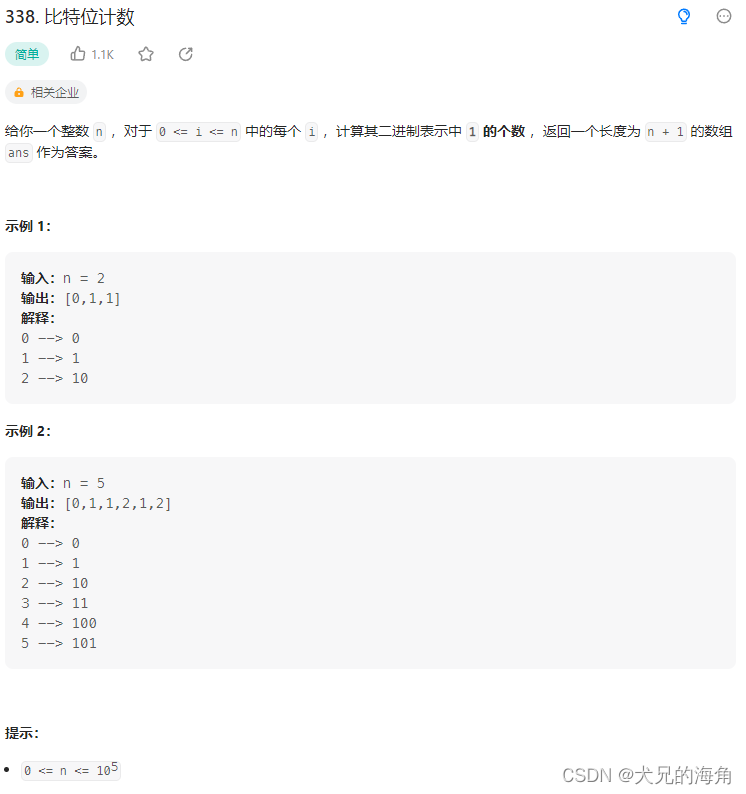
1、Brian Kernighan 算法
算法的核心思想在于对于任意整数x,每次都将x与x-1相与,从而让其二进制的最后一位1变成0。我们可以利用算法计算出每一个数的1的个数并输出。
class Solution {
public:
int countOnes(int x) {
int ones = 0;
while (x > 0) {
x &= (x - 1);
ones++;
}
return ones;
}
vector<int> countBits(int n) {
vector<int> bits(n + 1);
for (int i = 0; i <= n; i++) {
bits[i] = countOnes(i);
}
return bits;
}
};
2、找规律
Bits[0]=0,Bits[1]=1,而后偶数位的值等于其一半的值,奇数位的值等于上一个的值加1。
vector<int> countBits(int n) {
if (n == 0) return {0};
vector<int> Bits(n + 1, 0);
Bits[1] = 1;
for (int i = 2; i <= n; ++i) {
if (i % 2 == 0) Bits[i] = Bits[i / 2];
else Bits[i] = Bits[i - 1] + 1;
}
return Bits;
}
3、动态规划法-最高有效位
我们可以利用highBits记录当前的最高有效位:1、若 i & ( i ? 1 ) = 0 i \&(i-1)=0 i&(i?1)=0,说明当前值为2的幂,只有一个有效的1,最高有效位更新为i;2、i比i-highBits的二进制表示多一个1,令 b i t s [ i ] = b i t s [ i ? h i g h B i t s ] + 1 bits[i]=bits[i-highBits]+1 bits[i]=bits[i?highBits]+1。
class Solution {
public:
vector<int> countBits(int n) {
vector<int> bits(n + 1);
int highBit = 0;
for (int i = 1; i <= n; i++) {
if ((i & (i - 1)) == 0) {
highBit = i;
}
bits[i] = bits[i - highBit] + 1;
}
return bits;
}
};
4、动态规划法-最低有效位
我们将当前数字除二,相当于右移一位,此时若当前值为偶数则末位为0无影响;若为奇数则需要加1。相当于 b i t s [ i ] = b i t s [ i / 2 ] + i % 2 bits[i]=bits[i/2]+i \% 2 bits[i]=bits[i/2]+i%2。实际上等同于方法二。
class Solution {
public:
vector<int> countBits(int n) {
vector<int> bits(n + 1);
for (int i = 1; i <= n; i++) {
bits[i] = bits[i >> 1] + (i & 1);
}
return bits;
}
};
5、动态规划法-最低设置位
根据Brian Kernighan 算法,实际上 i & ( i ? 1 ) i \&(i-1) i&(i?1)相当于找到i二进制表示中最后一位为1的数改为为0的数,因此显然 B i t s [ x ] = B i t s [ x & ( x ? 1 ) ] + 1 Bits[x]=Bits[x \&(x-1)]+1 Bits[x]=Bits[x&(x?1)]+1。
class Solution {
public:
vector<int> countBits(int n) {
vector<int> bits(n + 1);
for (int i = 1; i <= n; i++) {
bits[i] = bits[i & (i - 1)] + 1;
}
return bits;
}
};